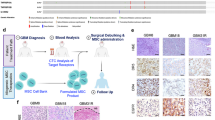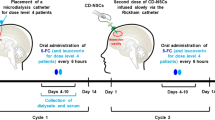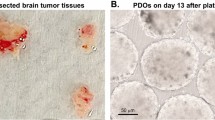Abstract
The prognosis of medulloblastoma has improved significantly because of advances in multi-modal treatments; however, metastasis remains one of the prognostic factors for a poor outcome and is usually associated with tumor recurrence. We evaluated the migratory potential and therapeutic efficacy of genetically engineered human neural stem cells (NSCs) that encode a prodrug enzyme in the subdural medulloblastoma model. We genetically modified HB1.F3 (F3) immortalized human NSCs to express rabbit carboxylesterase (rCE) enzyme, which efficiently converts the prodrug CPT-11 (Irinotecan) into an active anti-cancer agent (SN-38). To simulate clinical metastatic medulloblastomas, we implanted human medulloblastoma cells into the subdural spaces of nude mice. rCE expressing NSCs (F3.rCE) were labeled with fluorescence magnetic nanoparticle for in vivo imaging. The therapeutic potential of F3.rCE was confirmed using a mouse subdural medulloblastoma model. The majority of intravenously (i.v.) injected, F3.rCE cells migrated to the subdural medulloblastoma site and a small number of F3.rCE cells were found in the lungs, pancreas, kidney and liver. Animals that received F3.rCE cells in combination with prodrug CPT-11 survived significantly longer (median survival: 142 days) than control mice that received F3.rCE cells only (median survival: 80 days, P<0.001) or CPT-11 only (median survival: 118 days, P<0.001). In conclusion, i.v. injected F3.rCE NSCs were able to target subdural medulloblastomas and demonstrate therapeutic efficacy. Our study provides data that supports further investigation of stem-cell-based gene therapy against metastatic medulloblastomas.
This is a preview of subscription content, access via your institution
Access options
Subscribe to this journal
Receive 12 print issues and online access
$259.00 per year
only $21.58 per issue
Buy this article
- Purchase on Springer Link
- Instant access to full article PDF
Prices may be subject to local taxes which are calculated during checkout





Similar content being viewed by others
References
Packer RJ, Sutton LN, Elterman R, Lange B, Goldwein J, Nicholson HS et al. Outcome for children with medulloblastoma treated with radiation and cisplatin, CCNU, and vincristine chemotherapy. J Neurosurg 1994; 81: 690–698.
David KM, Casey AT, Hayward RD, Harkness WF, Phipps K, Wade A . Medulloblastoma: is the 5-year survival rate improving? A review of 80 cases from a single institution. J Neurosurg 1997; 86: 13–21.
Habrand JL, De Crevoisier R . Radiation therapy in the management of childhood brain tumors. Childs NervSyst 2001; 17: 121–133.
Patrice SJ, Tarbell NJ, Goumnerova LC, Shrieve DC, Black PM, Loeffler JS . Results of radiosurgery in the management of recurrent and residual medulloblastoma. Pediatr Neurosurg 1995; 22: 197–203.
Graham ML, Herndon JEII, Casey JR . High-dose chemotherapy with autologous stem-cell rescue in patients with recurrent and high-risk pediatric brain tumors. J Clin Oncol 1997; 15: 1814–1823.
Mulhern RK, Palmer SL, Merchant TE, Wallace D, Kocak M, Brouwers P et al. Neurocognitive consequences of risk-adapted therapy for childhood medulloblastoma. J Clin Oncol 2005; 23: 5511–5519.
Chang DY, Yoo SW, Hong Y, Kim S, Kim SJ, Yoon SH et al. The growth of brain tumors can be suppressed by multiple transplantation of mesenchymal stem cells expressing cytosine deaminase. Int J Cancer 2010; 127: 1975–1983.
Shimato S, Natsume A, Takeuchi H, Wakabayashi T, Fujii M, Ito M et al. Human neural stem cells target and deliver therapeutic gene to experimental leptomeningeal medulloblastoma. Gene Ther 2007; 14: 1132–1142.
Kim SK, Cargioli TG, Machluf M, Yang W, Sun Y, A-Hashem R et al. PEX-producing human neural stem cells inhibit tumor growth in a mouse glioma model. Clin Cancer Res 2005; 11: 5965–5970.
Aboody KS, Bush RA, Garcia E, Metz MZ, Najbauer J, Justus KA et al. Development of a tumor-selective approach to treat metastatic cancer. PLoS ONE 2006; 1: 1–10.
Joo KM, Park IH, Shin JY, Jin J, Kang BG, Kim MH et al. Human neural stem cells can target and deliver therapeutic genes to breast cancer brain metastases. Mol Ther 2009; 17: 570–575.
Danks MK, Yoon KJ, Bush RA, Remack JS, Wierdl M, Kim SU et al. Tumor-targeted enzyme/prodrug therapy mediates long-term disease-free survival of mice bearing disseminated neuroblastoma. Cancer Res 2007; 67: 22–25.
Dachs GU, Tupper J, Tozer GM . From bench to bedside for gene-directed enzyme prodrug therapy of cancer. Anticancer Drugs 2005; 16: 349–359.
McGregor LM, Spunt SL, Furman WL, Stewart CF, Schaiquevich P, Krailo MD et al. Phase 1 study of oxaliplatin and irinotecan in pediatric patients with refractory solid tumors: a children′s oncology group study. Cancer 2009; 115: 1765–1775.
Tanizawa A, Fujimori A, Fujimori Y, Pommier Y . Comparison of topoisomerase I inhibition, DNA damage, and cytotoxicity of camptothecin derivatives presently in clinical trials. J Natl Cancer Inst 1994; 86: 836–842.
Guemei AA, Cottrell J, Band R, Hehman H, Prudhomme M, Pavlov MV et al. Human plasma carboxylesterase and butyrylcholinesterase enzyme activity: correlations with SN-38 pharmacokinetics during a prolonged infusion of irinotecan. Cancer Chemother Pharmacol 2001; 47: 283–290.
Danks MK, Morton CL, Krull EJ, Cheshire PJ, Richmond LB, Naeve CW et al. Comparison of activation of CPT-11 by rabbit and human carboxylesterases for use in enzyme/prodrug therapy. Clin Cancer Res 1999; 5: 917–924.
Wagner LM, Guichard SM, Burger RA, Morton CL, Straign CM, Ashmun RA et al. Efficacy and toxicity of a virusdirected enzyme prodrug therapy purging method: preclinical assessment and application to bone marrow samples from neuroblastoma patients. Cancer Res 2002; 62: 5001–5007.
Wierdl M, Morton CL, Weeks JK, Danks MK, Harris LC, Potter PM . Sensitization of human tumor cells to CPT-11 via adenoviral-mediated delivery of a rabbit liver carboxylesterase. Cancer Res 2001; 61: 5078–5082.
Lee HJ, Kim KS, Kim EJ, Choi HB, Lee KH, Park IH et al. Brain transplantation of immortalized human neural stem cells promotes functional recovery in mouse intracerebral hemorrhage stroke model. Stem Cells 2007; 25: 1204–1212.
Kim SU, Nagai A, Nakagawa E, Choi HB, Bang JH, Lee HJ et al. Production and characterization of immortal human neural stem cell line with multipotent differentiation property. Methods Mol Biol 2008; 438: 103–121.
Kim SU, de Vellis J . Stem cell-based cell therapy in neurological diseases: a review. J Neurosci Res 2009; 87: 2183–2200.
Cargioli TG, Ugur HC, Ramakrishna N, Chan J, Black PM, Carroll RS . Establishment of an in vivo meningioma model with human telomerase reverse transcriptase. Neurosurgery 2007; 60: 750–759.
Schmidt KF, Ziu M, Schmidt NO, Vaghasia P, Cargioli TG, Doshi S et al. Volume reconstruction techniques improve the correlation between histological and in vivo tumor volume measurements in mouse models of human gliomas. J Neurooncol 2004; 68: 207–215.
Yin J, Kim JK, Moon JH, Beck S, Piao D, Jin X et al. hMSC-mediated concurrent delivery of endostatin and carboxylesterase to mouse xenografts suppresses glioma initiation and recurrence. Mol Ther 2011; 19: 1161–1169.
Gutierrez AA, Lemoine NR, Sikora K . Gene therapy for cancer. Lancet 1992; 339: 715–721.
Moolten FL . Drug sensitivity (‘suicide’) genes for selective cancer chemotherapy. Cancer Gene Ther 1994; 1: 279–287.
Wierdl M, Tsurkan L, Hyatt JL, Edwards CC, Hatfield MJ, Morton CL et al. An improved human carboxylesterase for enzyme/prodrug therapy with CPT-11. Cancer Gene Ther 2008; 15: 183–192.
Jurvansuu J, Zhao Y, Leung DS, Boulaire J, Yu YH, Ahmed S et al. Transmembrane protein 18 enhances the tropism of neural stem cells for glioma cells. Cancer Res 2008; 68: 4614–4622.
Acknowledgements
This study was supported by grants from the National R&D Program for Cancer Control, Ministry of Health & Welfare, Republic of Korea (08203103_22650) by the National Research Foundation of Korea (NRF) grant and funded by the Korea government (MEST) (2008-0061821). We thank CJ Cheiljedang for providing CPT-11.
Author information
Authors and Affiliations
Corresponding authors
Ethics declarations
Competing interests
The authors declare no conflict of interest.
Rights and permissions
About this article
Cite this article
Lim, SH., Choi, S., Lee, J. et al. Therapeutic targeting of subdural medulloblastomas using human neural stem cells expressing carboxylesterase. Cancer Gene Ther 18, 817–824 (2011). https://doi.org/10.1038/cgt.2011.52
Received:
Revised:
Accepted:
Published:
Issue Date:
DOI: https://doi.org/10.1038/cgt.2011.52
Keywords
This article is cited by
-
Gene Delivery in Neuro-Oncology
Current Oncology Reports (2017)
-
In vivo bioluminescence imaging for leptomeningeal dissemination of medulloblastoma in mouse models
BMC Cancer (2016)
-
Double suicide gene therapy using human neural stem cells against glioblastoma: double safety measures
Journal of Neuro-Oncology (2014)
-
Neural stem cell-mediated CE/CPT-11 enzyme/prodrug therapy in transgenic mouse model of intracerebellar medulloblastoma
Gene Therapy (2013)
-
Human neural stem cells expressing carboxyl esterase target and inhibit tumor growth of lung cancer brain metastases
Cancer Gene Therapy (2013)



